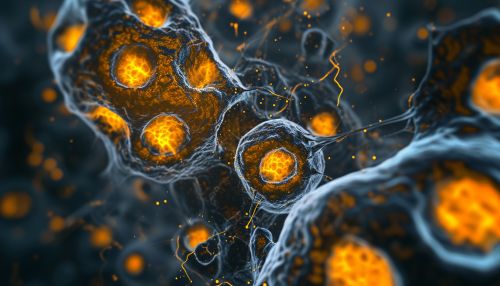Urea cycle
Introduction
The Urea cycle is a series of biochemical reactions that produces urea from ammonia (NH3). This cycle occurs in many organisms, including humans, and is crucial for the removal of excess nitrogen. The urea cycle was the first metabolic cycle to be discovered, and it is also known as the ornithine cycle due to the key role played by the amino acid Ornithine.
Biochemical Reactions
The urea cycle consists of five main biochemical reactions, which are catalyzed by five different enzymes. The cycle begins in the mitochondria of liver cells, where two molecules of ammonia and one molecule of carbon dioxide (CO2) are converted into urea.
Step 1: Formation of Carbamoyl Phosphate
The first step in the urea cycle is the formation of carbamoyl phosphate from one molecule of bicarbonate (HCO3-) and one molecule of ammonia, a reaction catalyzed by the enzyme Carbamoyl phosphate synthetase I. This reaction also requires two molecules of ATP, which are hydrolyzed to ADP.


Step 2: Formation of Citrulline
The second step involves the condensation of carbamoyl phosphate and ornithine to form citrulline. This reaction is catalyzed by the enzyme Ornithine transcarbamylase.
Step 3: Formation of Argininosuccinate
In the third step, citrulline is combined with aspartate to form argininosuccinate. This reaction is catalyzed by the enzyme Argininosuccinate synthetase, and it requires ATP.
Step 4: Cleavage of Argininosuccinate
The fourth step is the cleavage of argininosuccinate to form fumarate and arginine. This reaction is catalyzed by the enzyme Argininosuccinate lyase.
Step 5: Formation of Urea
The final step in the urea cycle is the hydrolysis of arginine to form urea and ornithine. This reaction is catalyzed by the enzyme Arginase.
Regulation of the Urea Cycle
The urea cycle is tightly regulated to ensure that nitrogen waste is efficiently removed from the body. The key regulatory points in the cycle are the activities of the enzymes carbamoyl phosphate synthetase I and ornithine transcarbamylase.
Clinical Significance
Defects in the urea cycle can lead to a group of disorders known as Urea Cycle Disorders (UCDs). These are inherited metabolic disorders that result in a deficiency of one of the enzymes in the urea cycle. Symptoms of UCDs can range from mild to severe, and they can present at any age.
